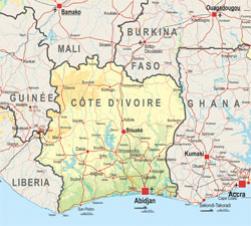Côte d’IvoireDownload light PDF version
Overview
Côte d’Ivoire plays a leading role in West Africa and any damage to its economy greatly impacts the rest of the sub-region. Indeed, as a consequence of a decade-long crisis that started in 2001, Abidjan’s position as the main access to the sea for its landlocked northern neighbours has lost its relevance and focus has shifted to alternative transport corridors, such as the ports of Cotonou (Benin), Lomé (Togo) and Tema (Ghana).
Despite political instability, Côte d'Ivoire is still the largest economy of the West African Economic and Monetary Union (UEMOA) and accounts for a third of the total GDP of the Union. This is largely due to high international cocoa prices and a strong agricultural sector and construction activities. The IMF has forecasted promising economic prospects and further recovery in 2012. Continued political stability and national reconciliation will be crucial in regaining the confidence of reluctant foreign investors.
Côte d’Ivoire is an ethnically and culturally diverse country. Four major ethno-linguistic groups make up a unique mosaic of West Africa: Kru-speaking people are mostly based in the southwest quarter, Akan-speaking people in the Southeast, Mandingo-speaking people in the Northwest and Voltaic people in the Northeast. Intense human mobility has complicated and enriched the original context, including migration to the West African cocoa and coffee basin and to the port of San Pedro. According to recent data published by the World Bank, the total number of immigrants is estimated at 2.4 million, representing 11.2% of the population, mainly coming from other West African countries.
Côte d'Ivoire, along with Mali and Burkina Faso, accounts for the largest African cotton area and with Ghana, the largest cocoa basin in the world. Nearly 60% of its territory is located in cross-border river basins (Sassandra Komoé, including Bia). Abidjan is home to the UEMOA Regional Stock Exchange (BRVM) and will soon host again the African Development Bank headquarters.
A major challenge for Côte d’Ivoire’s economic development is frequent electricity outages. Following a turbine failure in late 2009, Côte d’Ivoire has had to begin importing electricity from Ghana. A 2009 study by the UEMOA Commission indicates that electricity shortages are one of the biggest impediments to business productivity and competitiveness in the UEMOA zone.
Food Security
| Global Hunger Index (IFPRI 2011): | 18 |
| Food supply (kcal per capita/day): | 2 515 |
| Number of people undernourished: | 2.8 million |
:Percentage of people undernourished: | 14% |
| Child malnutrition, underweight: | 20% |
| Child malnutrition, stunting: | 34% |
Land use
| Land area (1 000 ha): | 31 800 |
| Agricultural land area (1 000 ha): | 20 300 |
Arable land (1 000 ha): | 2 800 |
| Permanent crops (1 000 ha): | 4 250 |
| Pastures (1 000 ha): | 13 200 |
| Irrigated land (1 000 ha): | 73 |
| Share in total water use by |
|
| Forest area (1000 ha): | 10 403 |
Source: FAOStat and FAO Country Profile

